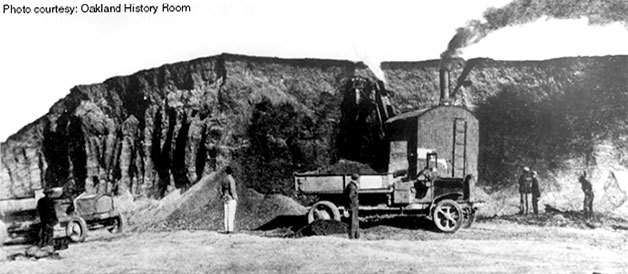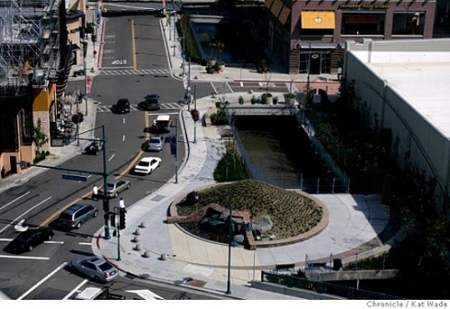For the Glory of Gold and Bones: Spiritual Accumulation and Grave Theft
in the Construction of the San Francisco Bay Area
As U.S. settler colonial empire expanded into California during the nineteenth century, the Gold Rush brought hundreds of thousands of settlers who unleashed a brutal genocidal project of terror against Indigenous peoples [1]. From the first day of their arrival, California settlers brought with them a blood lust which defines their ‘war of extermination’ against Californian Indigenous peoples as the most rapidly destructive period of genocide to occur in U.S history[2]. This project of genocide became institutionalized and funded by the state of California, as the ‘extermination’ of Indigenous peoples was recognized to directly correlate with the accumulation of United States settler wealth.
Immediately following the Gold Rush, the University of California (UC) was established in 1868, stating that it was “born out of a vision […] of a university that would ‘contribute even more than California’s gold to the glory and happiness of advancing generations.’” The “contribution of California’s gold” to the “glory of its advancing generations” refers to this horrific genocide, wherein the space of twenty years, the California Indigenous population was reduced by more than 70 percent[3]. Inherent in the accumulation of settler wealth, prosperity, and futurity is the requisite demise and eradication of Indigenous life, futurity, and memory.
The University of California was established on Ohlone homelands on the site of what is today the city of Berkeley. The UC’s Department of Anthropology rose to prominence through the recruitment of renowned anthropologists, who were enticed to come to the Bay Area (occupied Ohlone homelands) through the promise of the ‘rich discovery’ that Ohlone burial sites (known as ‘shellmounds’) held as archaeological resources (referring to Ohlone human remains)[4].
In this project, I investigate the historical development and construction of the San Francisco Bay Area through the excavation, desecration, and museum collection of Ohlone dead, which I situate within the broader context of U.S. ‘skull-collecting’ during Westward Expansion[5]. I trace how the bones of Ohlone ancestors are imbued with shifting settler desires and notions of (de)valuation which inform and correlate with the rationalization and designation of spatial use in which they are located. By tracing a genealogical history of the construction of the Bay Area through the desecration of Ohlone shellmounds, I trace the Bay Area’s shifting temporal and spatial arrangements of accumulation and dispossession through racialized and gendered modalities of death-making and death management. This project asks, how are the dead and the space of afterlife central to the formation of settler colonial expansion and capital production? How do the dead influence, shape, and/or disrupt settler colonial occupation? In turn, I look to the work of Indigenous-led decolonial collaborations on Ohlone homelands which work to reconceptualize and reclaim Ohlone homelands through the centering of sacred knowledges which revitalize consensual and reciprocal relationships with land.

This picture illustrates the razing and destruction of the Emeryville Shellmound in 1924 by W. Egbert Schenk.
Prior to this destruction, the Emeryville Shellmound was the largest of the hundreds of shellmounds built by Ohlone peoples. Constructed over an estimated period of 2,500 years, the Emeryville Shellmound is estimated to have originally rose to over 60 feet high and 350 feet in diameter.
By the time of 1925, the University of California had removed over 700 bodies of Ohlone ancestors from the Emeryville Shellmound alone, who were then stored at the Hearst Museum.
Despite all this destruction, much of the shellmound, including its burials, remain below ground level.

Today, the Emeryville Shellmound lies underneath Emeryville’s Bay Street shopping mall.
Following Schenk’s 1925 razing of the shellmound, the site was then used for industrial development and host to the toxic waste of an abandoned paint processing plant until the construction of the Bay Street mall in the early 2000s.
As much of the shellmound, including its burials, remain below ground level, hundreds of human remains of Ohlone ancestors are buried in various locations underneath the mall’s stores and parking lots.
[1]I define settler colonialism as a material (and immaterial) structure and process of ongoing dispossession, sustained through gendered formations of Indigenous elimination. See: Eve Tuck and K. Wayne Yang. “Decolonization is Not a Metaphor.” Decolonization: Indigeneity, Education & Society. (Volume 1, Number 1, 2012) pp. 1-40.
[2]Roxanne Dunbar-Ortiz, An Indigenous Peoples’ History of the United States (Boston: Beacon Press, 2014).
[3]Ibid., p. 129.
[4]The UC Department of Anthropology was established at the urging of Franz Boas to partake in the practice of ‘salvage anthropology,’ which refers to the settler belief that Native peoples were going extinct and that anthropologists had to rush to document everything about them before they fully vanished.
[5]For more on ‘skull-collecting,’ see Lonetree, Decolonizing Museums.
For more information see:
